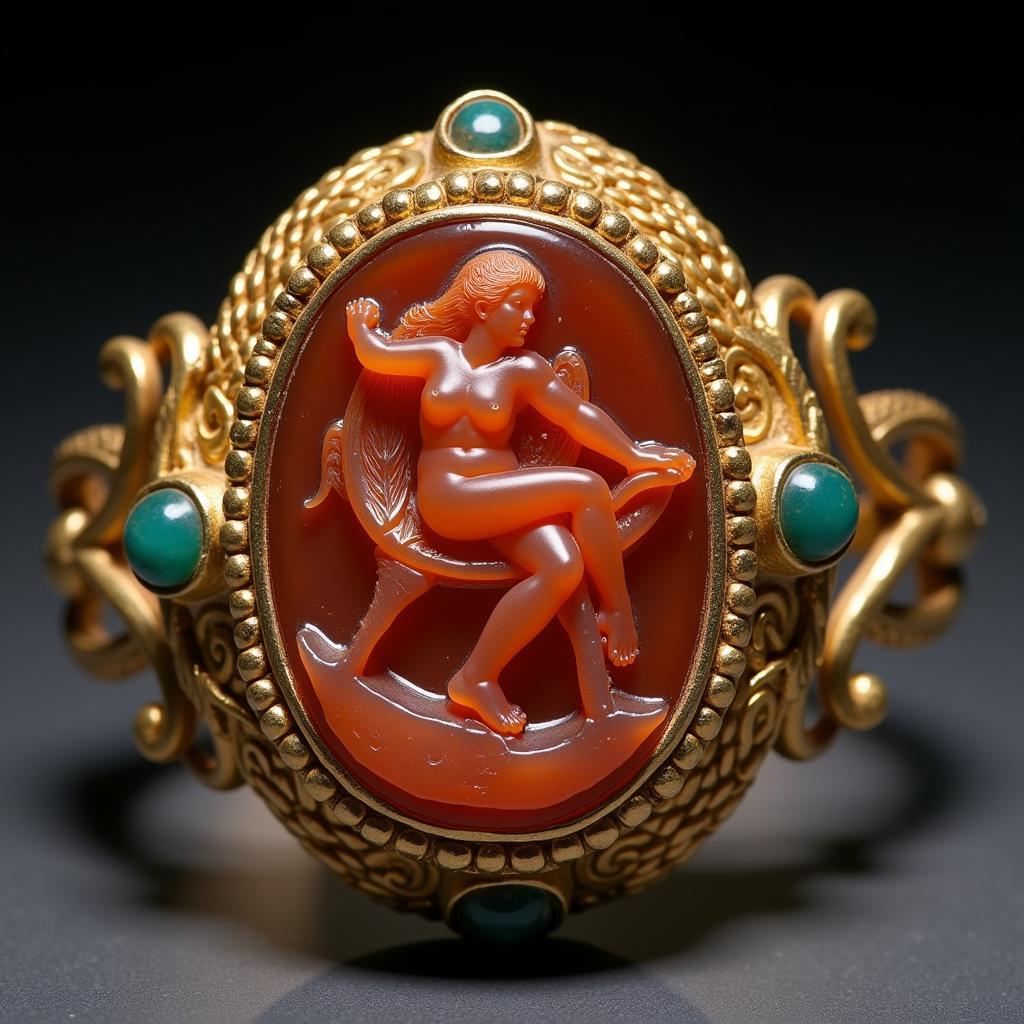Roman Era Rings offer a fascinating window into the artistry, beliefs, and daily lives of this ancient civilization. More than just adornments, these rings served as status symbols, tokens of affection, and even tools for everyday tasks. From the elaborate designs favored by the elite to the simpler bands worn by common folk, Roman era rings provide a tangible connection to a bygone era.
 Roman Era Ring
Roman Era Ring
Materials and Techniques: A Testament to Skill
Roman artisans were renowned for their skill in crafting jewelry, and their rings were no exception. Gold, silver, and bronze were the most common metals used, often combined with precious and semi-precious stones. Intricate designs were created using a variety of techniques, including:
- Granulation: Tiny metal spheres were meticulously applied to the surface of the ring, creating intricate patterns and textures.
- Filigree: Delicate wires of gold or silver were twisted and soldered together to form intricate openwork designs.
- Intaglio: A design was carved into the surface of a gemstone, creating a raised image when pressed into wax or clay. This technique was often used for signet rings.
 Roman Ring Making
Roman Ring Making
Symbolism and Significance: Beyond mere Adornment
Roman era rings carried deep symbolism and served multiple purposes beyond their aesthetic appeal. Some common themes and their interpretations include:
- Snakes: Often depicted biting their own tails (ouroboros), snakes symbolized eternity, renewal, and the cyclical nature of life.
- Gods and Goddesses: Rings depicting deities served as expressions of faith and were believed to offer protection and favor.
- Animals: Animals like lions, eagles, and horses represented strength, power, and victory.
Signet rings, engraved with initials or family crests, were essential tools for authentication and sealing documents. Wedding rings, a tradition that continues today, symbolized the enduring bond of marriage.
Roman Era Rings Today: Echoes of the Past
Today, Roman era rings continue to captivate collectors and history enthusiasts alike. Museums and private collections house exquisite examples of these ancient treasures, offering glimpses into the artistry and beliefs of a bygone era. Replicas and modern interpretations of Roman era ring designs remain popular, allowing individuals to connect with the elegance and history they represent.
Whether you are drawn to the intricate craftsmanship, the fascinating symbolism, or simply the enduring allure of ancient history, Roman era rings offer a tangible link to the past and a timeless testament to human creativity.
Frequently Asked Questions about Roman Era Rings
What are Roman era rings made of?
Roman era rings were crafted from a variety of materials, including gold, silver, bronze, and a range of precious and semi-precious stones like emeralds, garnets, and carnelian.
What is the significance of a snake ring from the Roman era?
Snakes, often depicted as ouroboros (biting their own tails), symbolized eternity, renewal, and the cyclical nature of life in Roman culture.
Were Roman era rings only worn by the wealthy?
While elaborate rings were indeed status symbols favored by the elite, simpler rings made from less expensive materials were also worn by commoners for various purposes.
What are intaglio rings, and how were they used?
Intaglio rings featured a design carved into the surface of a gemstone. When pressed into wax or clay, they created a raised image, serving as a personal signature or seal for documents.
Where can I see Roman era rings today?
Museums worldwide, particularly those with Roman art and archaeology collections, often house impressive displays of Roman era jewelry, including rings. You can also find them in private collections and online auction platforms.
Need More Information?
For any further inquiries or assistance, please feel free to reach out to us!
Contact Information:
- Phone: 0909802228
- Email: doibongda@gmail.com
- Address: 101 Đ. Lý Chiêu Hoàng, Phường 10, Quận 6, Hồ Chí Minh, Việt Nam
Our dedicated customer support team is available 24/7 to assist you.